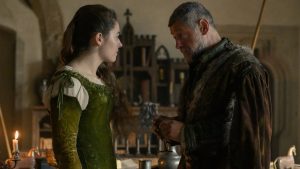Considering that I went into The Letter For The King expecting to be bored out of my mind, I was actually quite pleasantly surprised with what I got: which, indeed, is mostly a blend of various tired fantasy tropes and scenes or even entire characters plucked straight from other, better, works of art, but also has just enough new – or mostly new – content to distance itself from the pack.
Based on an obscure Dutch fantasy novel from the 1960’s, The Letter For The King simply doesn’t have the name recognition that would enable it to jump into the midst of Netflix’s crowded schedule with a built-in fanbase. In English-speaking countries, there wasn’t even a proper translation of the novel until a few years ago. So it’s unsurprising that the six-part series has to look for inspiration elsewhere: almost the entire plot is comprised of original content, and almost all of that original content is…shall we say, lifted, from fantasy books, films and TV series as wide-ranging as The Lord Of The Rings, Game Of Thrones, The Witcher, The Chronicles Of Prydain and Starlight. The latter two, with their largely simplistic worlds, basic magic systems, and archetypal characters, are by far the most obvious source material – even with Lord Of The Rings trilogy production designer Ra Vincent working behind the scenes, The Letter For The King still looks and feels like a small-scale children’s fable (and that’s not a criticism of Prydain or Starlight, by the way: both are fabulous) that might have attracted more attention if it had been released fifteen years ago, when studios were trying desperately to replicate the success of The Lord Of The Rings by using as little money and effort as possible. These days, as the hunt for the next Game Of Thrones heats up, The Letter For The King, with its antiquated fairytale style and low stakes, has little chance of being an underdog champion like its protagonist, Tiuri (alternately pronounced “Tiuri” or “Churri” – I doubt it was intentional, but the constantly changing pronunciations of his name often reminded me of a similar problem in Ralph Bakshi’s cult classic The Lord Of The Rings, where the villain Saruman’s name was changed halfway through production to “Aruman”, leading to a perplexing continuity error).

Oftentimes, adaptations of fantasy and sci-fi literature fail because they try to excessively build their worlds rather than doing the same with their characters or plot: cramming detail and deep lore into every inch of your expansive world is certainly much more fun than patching up plot-holes or charting character arcs, but if done incorrectly, it can bog down a film or TV series within minutes, as the audience struggles to catch up with a constant flow of place names, history lessons and nonsensical exposition dumps. The Letter For The King somehow does the exact opposite and still runs into a problem: because it does the bare minimum to flesh out its world (for example, the world actually has no name: its simply referred to as “three kingdoms”), it ends up looking like any of a thousand generic fantasy worlds – a sprinkling of vague magic, Medieval European societies dotting a map, and an obligatory Chosen One prophecy.
But once it becomes apparent that this is a problem (about five minutes in, I think?), the show starts hurling things at you that give the impression of depth: specifically, actors from other fantasy franchises. David Wenham, who portrayed Faramir, the young, idealistic son of a stern and demanding father, in The Lord Of The Rings, has here been upgraded to playing the stern and demanding father of a young, idealistic son (and make no mistake: he does a fantastic job of it). Andy Serkis, whose revolutionary motion-capture performance as the creature Gollum earned him worldwide renown, here delights in a brief cameo as an actual human being: something of a mix between the Master of Lake-town from The Hobbit and Capricorn, the villain of Inkheart (who, coincidentally, was also portrayed by Serkis in the film adaptation of that novel). Serkis’ daughter Ruby Ashbourne Serkis also shares the screen with him, playing his character’s daughter Lavinia, and then goes on to become the female lead of the series – her acting career is off to a good start, judging by the strength of her performance here. And in a very smart move, Kim Bodnia plays the sword-fighting abbot of the monastery at the edge of the world: Bodnia will portray the Witcher Vesemir in The Witcher‘s second season, and this is a tantalizing first look at what he could do in that role – Witcher fans would be smart to check out his fighting and acting skills here, and simultaneously give The Letter To The King some much-needed views.

Because despite being derivative, the series actually does have quite a lot of strong elements: especially if you’re into the more romanticized, outdated style of fantasy that was popular throughout the middle of the 20th Century. It has charm, for one thing – the series is TV-PG and family-friendly: a welcome break from The Witcher‘s gothic horror and Game Of Thrones‘ vicious brutality. And the core cast of characters are all fairly well developed: Tiuri, played by Amir Wilson, isn’t exactly a memorable hero, but he’s also not quite as dull as Starlight‘s Tristan or Prydain‘s Taran (what’s with all the T names, may I ask?). His character also has interesting things to say regarding the racial dynamics in his world – none of which ever actually get said, but still exist in subtext. Thaddea Graham’s hardened rogue Iona evolves into an Arya Stark prodigy (her final scene in the series actually seems to direct imitate one of Arya’s memorable scenes with The Hound from Game Of Thrones, season 8). Jussipo, initially one of the most annoying characters in the series, quickly shows his true colors as a delightfully smarmy, wickedly sarcastic bard. And along with gender and racial diversity, there’s even some surprising LGBTQ+ representation among the main cast – which, after all the recent queer-baiting from other studios, deserves a round of applause for how direct and straightforward it is.

Any good fantasy needs a good villain – a Cersei Lannister, a Smaug, a wicked old witch. The Letter For The King has an up-and-down relationship with its villain, Gijs Blom’s raven-haired goth necromancer Viridian: first it depicts him as a cartoonishly callous sadist without any moral complexity; then it tries to turn the tables on our heroes and reveal Viridian’s noble purpose, which actually works until said noble purpose turns out to be thinly-veiled racism; then it underutilizes him in its own finale before turning him into an overpowered Morgoth knock-off.
Speaking of which, we have to talk about the series’ poor use of action. Action, in a fantasy series, is something of a given: even if its special effects wizardry, you need some sort of action. The Letter For The King, being almost exclusively the story of Tiuri intercepting an incriminating letter from Viridian and trying to deliver it to a neighboring nation’s king, relies heavily on horseback fight and chase scenes. Now, these are easy to do right, with the help of a good cinematographer: in The Lord Of The Rings, Arwen and Frodo’s flight to the fords of Bruinen is a thrilling, suspenseful sequence where horses interlace between trees in a graceful, dangerous dance while Howard Shore’s score wails hauntingly in the background. Unfortunately, the thousands of horse chases in this series never once come close to paralleling that one epic scene, no matter how many times they pan over beautiful landscapes: the music accompanying these scenes is unmemorable, while the cinematography is questionable – mounting a camera on a horse’s head probably seemed like a good idea to make one chase scene more realistic, but did no one stop to consider that it takes the viewer out of the world completely?
It’s the same situation with the special effects budget. Most of the CGI seems to have been used up on Viridian’s finale transformation, meaning that throughout the rest of the series there’s just a bunch of patchy fire and smoke effects and one truly horrific CGI castle wall in the city of Unauwen – which was made doubly inexcusable because of how many times the city was made out to look like Game Of Thrones‘ Winterfell from afar, despite the fact that the one is a mess of bad special effects and the other was an almost entirely practical set.
So is The Letter For The King a must-see? Not by any means. But while we’re all self-quarantining, I don’t know if we’ve got any better options right now. And it’s actually not that bad. Pretty bad? Yeah, just a little. Game Of Thrones season 8 bad? No. Not even close.
Series Rating: 6/10
Just finished this series. I could make a colander with all the plot holes. But you are right, I was still mildly entertained. I’ve been so spoiled with meticulous and slower story development with LotR and GoT. “Well that escalated quickly” was a common utterance. Would have been nice to have it slowed down just a touch and add in one or two more episodes.